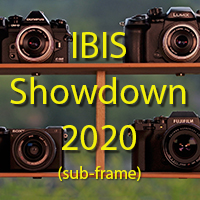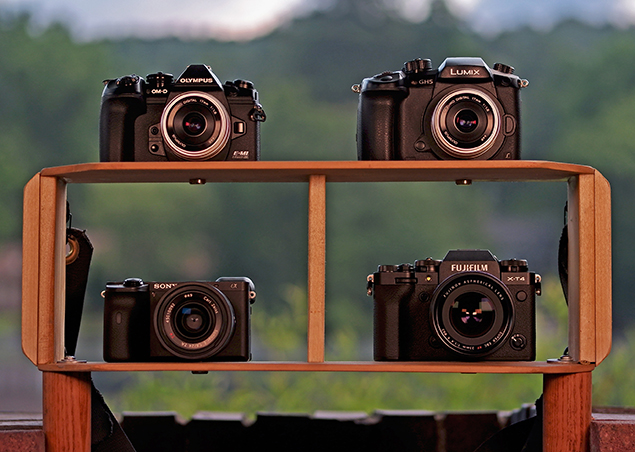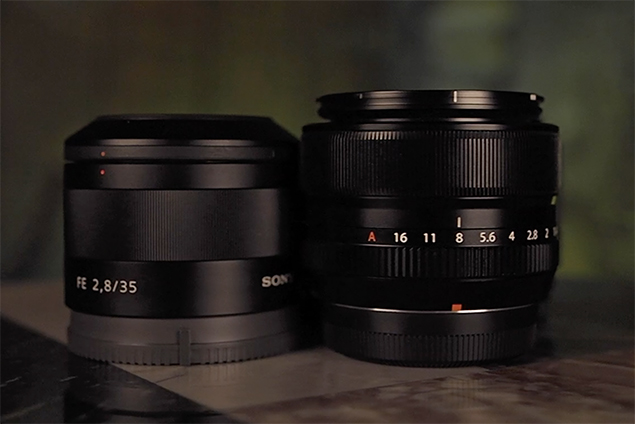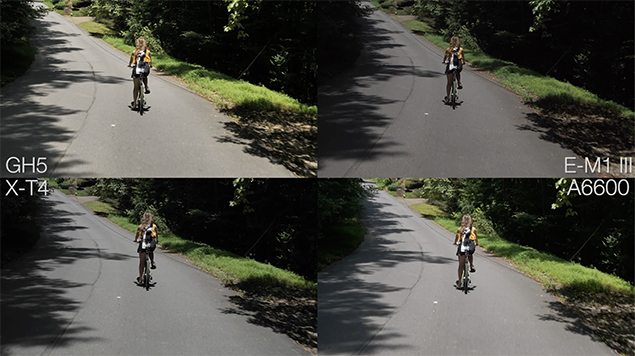IBIS Showdown 2020: GH5 vs X-T4 vs E-M1 III vs A6600 in a crop-sensor IS shakedown
posted Tuesday, July 21, 2020 at 1:56 PM EDT

In-body image stabilization is one of the current frontiers in the design of modern digital camera systems, and it allows for IS with any lens mounted to the camera. As your trusted resource for testing and comparisons, we felt it was time to pit some of the most popular enthusiast-grade cameras against each other to see which one can deliver the best results for in-body IS.
In this video, we'll compare four very popular crop-sensor cameras in the Olympus E-M1 III, the Fujifilm X-T4, the Panasonic GH5 and the Sony A6600.
IBIS Showdown 2020 (sub-frame)
*(Firmware for all four models updated in mid-June 2020 prior to filming these tests.)
Image stabilization is important for both still photography and video, but for our purposes here we'll compare IS on the video side of the equation, as it's both trickier to pull off and also easier to see the results as they happen. We'll begin with fairly easy shooting situations and then ramp up the difficulty level, culminating in a fairly challenging final test situation to fully showcase which camera body sports the toughest mettle in the IBIS department.
Professional videographers and filmmakers generally rely on dollies and gimbals for stabilization, which are reliable and effective, but these are also costly and add mass and weight to the set-up. For enthusiast filmmakers on-the-go, having the IS in the camera itself saves a tremendous amount of time and money, not to mention space, and is therefore more practical and economical. For this reason, the technological boundaries are continuing to be pushed by manufacturers to achieve the best IS for the end-users out there.
The Particulars
We've designed a special IS rig that allows up to four cameras to shoot the same scene while sustaining roughly the same bumps and shakes as we go, for a true apples-to-apples test of how the IS is handling each situation. We'll shoot with comparable prime lenses at both 35mm and 50mm equivalent fields of view, while employing lenses that are not equipped with optical IS.

Designed to shoot 4 enthusiast-grade digital cameras simultaneously
in order to showcase and compare the same scene filmed at the same time.
Image stabilization for video comes in a variety of flavors. Electronic (or digital) stabilization can be performed by the camera processor in real-time or on a computer after the fact, but in either case, it always requires that the camera/software crop into the image to achieve some latitude for moving it around to counteract shake. It's also a very hit-or-miss type thing, and we haven't found it to work very reliably nor effectively.
Optical stabilization occurs in the lens itself and is widely used in smartphones, compact cameras and, of course, numerous lenses in still camera systems. The biggest drawback is that IS in a lens requires more mass and weight for the lens, and is relatively more costly to install in multiple lenses than simply putting it into a camera body that can cover all lenses.

Due to the drawbacks of each of these types of shake correction, camera companies have gradually begun moving more and more to in-body image stabilization. IBIS uses precision sensors inside the body, such as gyros and accelerometers, to send movement information to a housing holding the image sensor, which then moves the sensor around in order to correct for camera shake and jitter.
Some systems now, such as ones from Panasonic and Olympus, are able to combine in-body stabilization with optical correction in some lenses, further improving the results. But since not all lenses come with optical IS, we're not going to use these in order to compare the effectiveness of the in-body systems on their own.

Thanks for watching, everyone. Stay tuned for more showdowns to come from us, for IBIS across various platforms and more!
• Watch on Youtube •
[Update 7-23-20: I experimented with varying the position of the cameras on the rig during testing, and did not see any noticeable difference. All cameras moved and vibrated at roughly the same rates regardless of locale, which was the intention all along. However, for the sceince-minded among you I will vary the positions on subsequent testing where possible.]